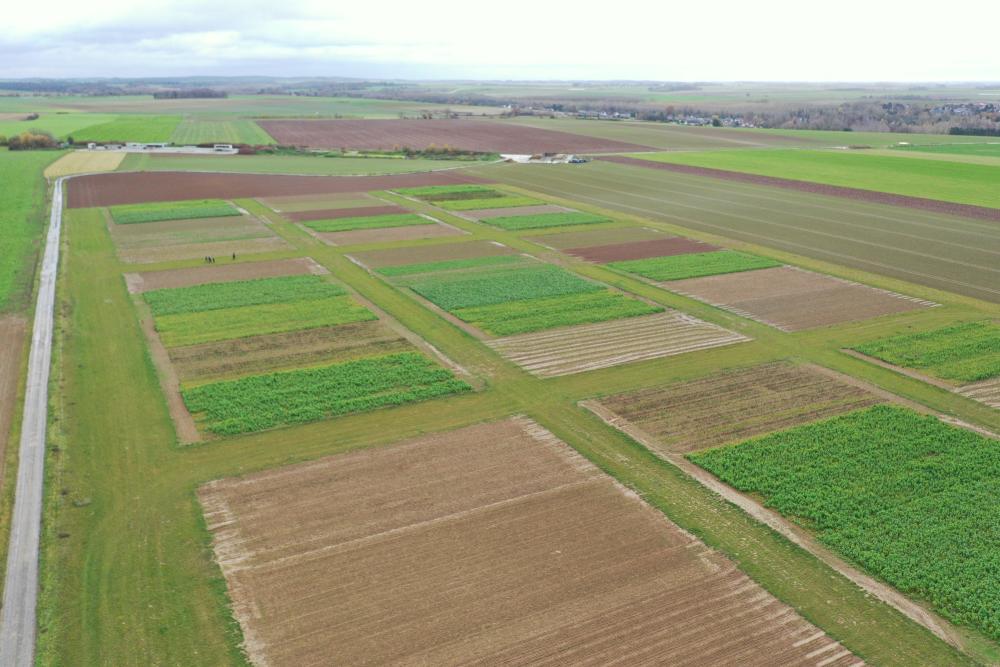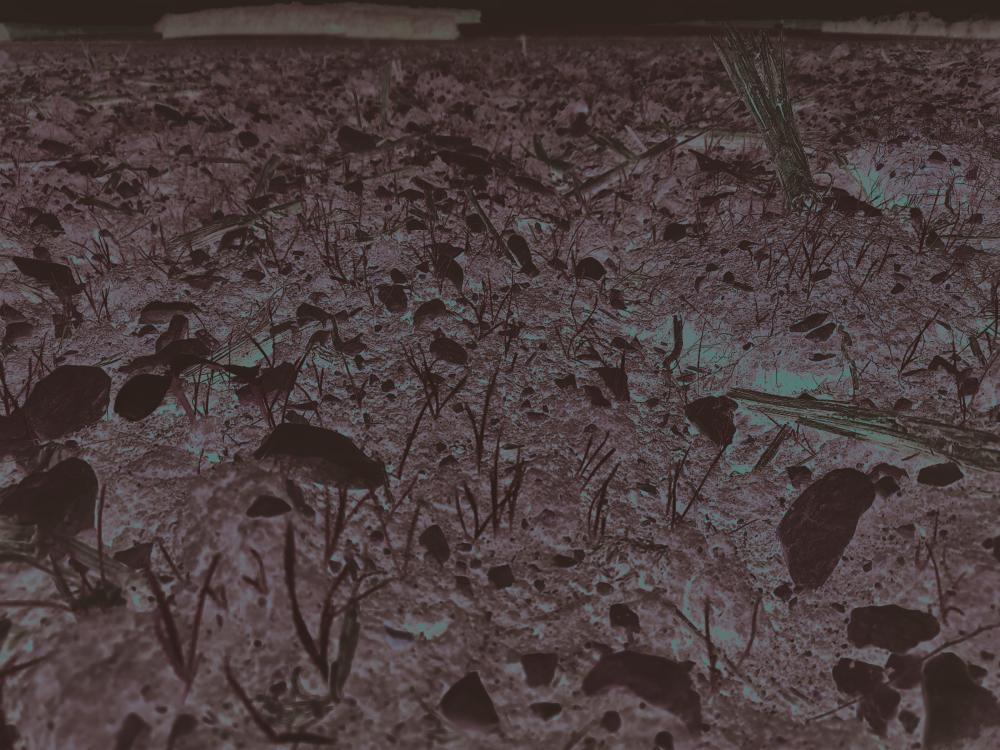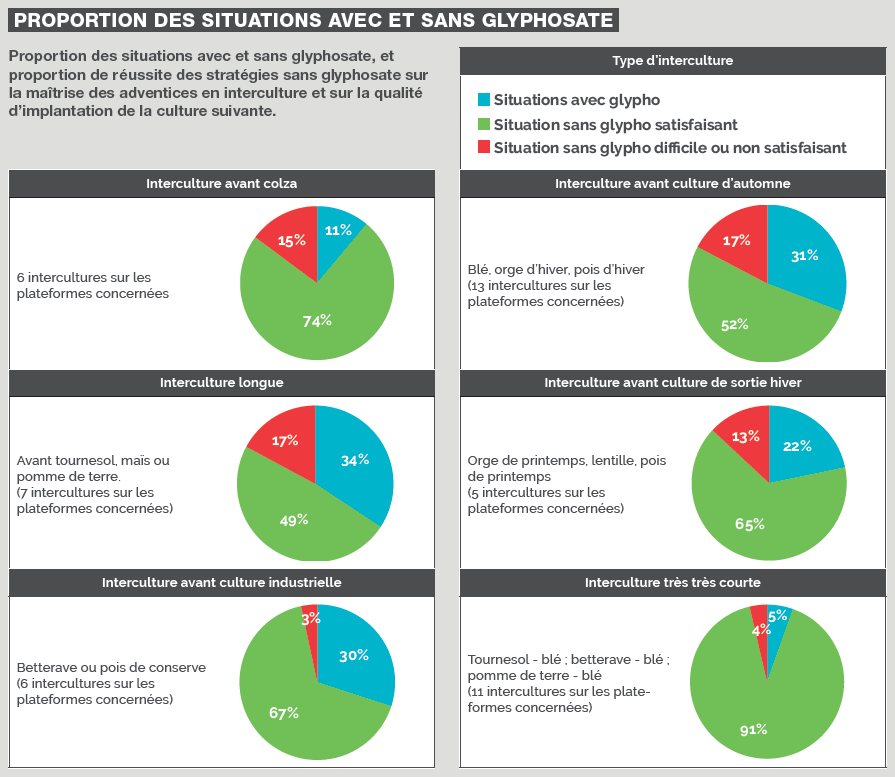Syppre platforms: assessment of the glyphosate ban
Syppre platforms: assessment of the glyphosate ban
The inter-institute system studies the practices implemented in the absence of glyphosate and their impact on weed control and crop establishment. Four sites are being used for field analysis.

Syppre Picardie platform.
Copyright: L. Jung, Terres Inovia.
Since 2016, the Syppre experimental platforms, an inter-institute initiative run by Terres Inovia, Arvalis and ITB, have been testing innovative systems designed to meet multi-performance objectives: maintaining or even improving margins and productivity, reducing dependence on inputs (nitrogen, plant protection products), reducing greenhouse gas (GHG) emissions and increasing soil organic matter levels.
They are compared with a control system whose rotations are representative of local systems and managed in an optimised way according to the advice of the technical institutes. In 2019, the trials have incorporated an additional objective: to use glyphosate only as a last resort and to mobilise other levers to manage weeds and the destruction of intercropping cover crops.
A long-term analysis
A study of practices implemented in the absence of glyphosate and their impact on weed control, particularly grass weeds, and crop establishment was carried out at the level of the cropping system and intercropping. The study covers 4 of the 5 platforms and compares the 2016 to 2018 cropping seasons (with glyphosate possibly included in the strategies) and the 2019 to 2021 cropping seasons (with glyphosate used as a last resort if no glyphosate is used).
The platforms studied are located in the following contexts: clay-limestone slopes in the Lauragais region (main problematic flora: ryegrass), clay-limestone soils with clay and sandy areas in the Berry region (main problematic flora: vulpine), deep loams in Picardy (main problematic flora: spring broadleaf weeds) and chalk soils in Champagne (main problematic flora: spring broadleaf weeds). In these specific cases, management strategies are identified and confirmed that have made it possible to dispense with glyphosate without damaging consequences, while situations of impasse persist despite the combination of weed control levers.
Different scenarios depending on the type of intercropping
When intercrops are grouped by category, certain trends emerge across the four platforms studied.
1. In long intercrops (such as wheat-sunflower or wheat-corn) using cover crops, the most successful situations without glyphosate are those involving either ploughing (at the start of winter for clay soils) or shallow tillage when the spring is fairly dry. Otherwise, the effectiveness of destroying weeds - particularly winter grasses - before sowing is more uncertain or even difficult and disappointing, particularly in clay soils.
2. In intercropping before industrial crops such as beetroot or tinned peas (Picardy and Champagne platforms on non-clay soils that are easier to work), ploughed situations are also satisfactory, and if not, working the soil not too early after winter (so potentially in less wet conditions) is satisfactory.
3. In intercrops before early sown crops such as spring barley, spring peas, chickpeas or lentils, the absence of glyphosate gives good results in ploughed situations or when it was possible to work the soil at the end of winter in good conditions (drained soil and dry weather) or in situations where the soil is not clayey (e.g. Champagne). In other cases, working the soil after winter has compromised its effectiveness, particularly on grass flora.

Vulpine weed emergence on the Berry platform.
Copyright: M. Loos, Terres Inovia.
4. In short intercrops, after a crop harvested in July and before an autumn crop such as cereals or winter peas, certain windows of intervention are correct for working the soil superficially in an effective manner, unless a cover crop is put in place until around 15 October. In this situation, putting a cover crop in place reduces the windows of intervention in dry weather; this can then be very restrictive when it comes to managing grasses in the autumn in wetter weather, particularly in clay soils. Even in the absence of a cover crop, the effectiveness of tillage can be uncertain depending on the soil and climate conditions, as grass seedlings or new shoots are possible, and in clay soils it is important to maintain a suitable structure for the following crop.
5. In intercrops before oilseed rape, there are generally few weeds to manage (dry period) but if this is not the case, working the soil to sow on clean soil in the absence of glyphosate runs the risk of drying out the seedbed. If there is a heavy infestation of grass weeds, which could suck up the useful reserves and hinder oilseed rape emergence, a glyphosate pass may be necessary to destroy these weeds and sow the oilseed rape directly, without mechanical tillage, which could also dry out the soil. To establish oilseed rape, the strategies of ploughing in non-clay soil or direct seeding have proved to be the most effective.
Variable tillage efficiency
Figure 1 shows that there are always situations where there is no solution, particularly when these different factors are combined: clay soil, wet conditions and/or grass infestation (especially if already developed) in the cover crop or afterwards (or in the intercropping period without cover crop). Outside these situations, glyphosate can be dispensed with by working the soil. However, the soil and climate conditions are crucial to success.
In fact, in wet conditions, the effectiveness of tillage in destroying grasses is more uncertain: they can re-sprout (especially if they are already developed) or new germination can be induced (fresh, disturbed soil); moreover, in clay soils, tillage in wet conditions can be fatal for the soil structure and therefore for the quality of the following crop.

Figure 1 (from Arvalis & Terres Inovia infos): Presentation by intercropping system (IC) of the proportion of situations with and without glyphosate, and the proportion of successes or failures of glyphosate-free strategies in terms of weed control during intercropping and the quality of establishment of the following crop. These figures are based solely on the innovative and control systems of the four Syppre platforms studied (Berry, Lauragais, Champagne and Picardy) between 2016 and 2021.
Contact : F. Vuillemin, f.vuillemin@terresinovia.fr